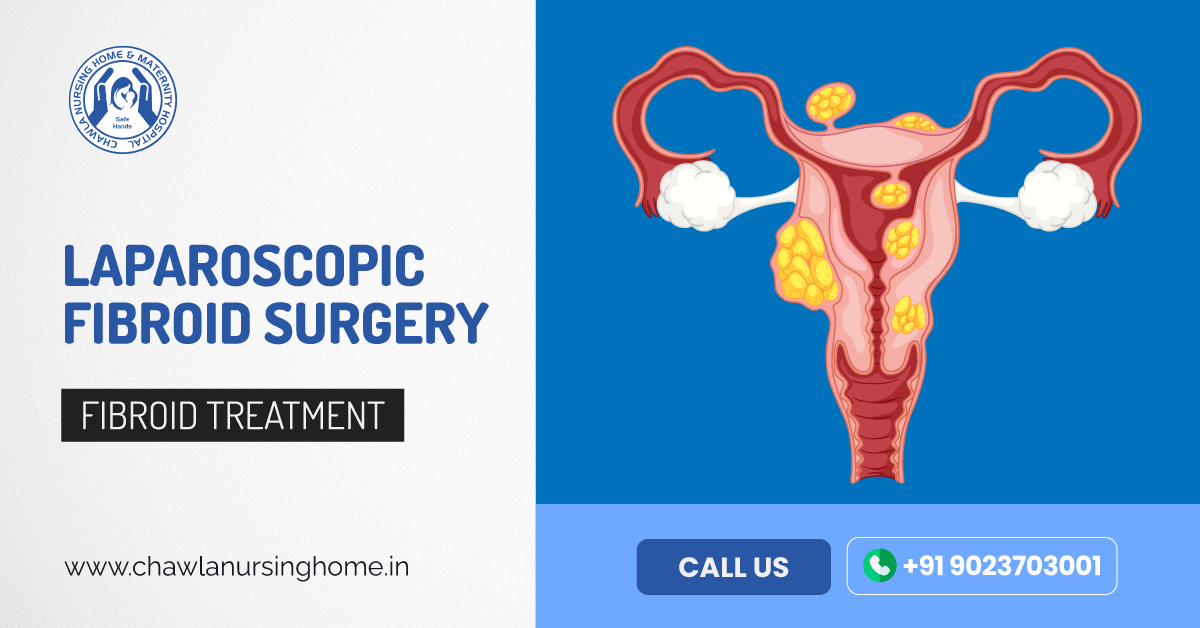
Fibroids Surgery in Jalandhar
Uterine fibroids are a common type of noncancerous tumour that can grow in and on your uterus. Not all fibroids cause symptoms, but when they do, symptoms can include heavy menstrual bleeding, back pain, frequent urination and pain during sex. Small fibroids often don’t need treatment, but larger fibroids can be treated with medications or surgery.
Uterine fibroids (also called leiomyomas) are growths made up of the muscle and connective tissue from the wall of the uterus. These growths are usually not cancerous (benign). Your uterus is an upside-down pear-shaped organ in your pelvis. The normal size of your uterus is similar to a lemon. It’s the place where a baby grows and develops during pregnancy.
Fibroids can grow as a single nodule (one growth) or in a cluster. Fibroid clusters can range in size from 1 mm to more than 20 cm (8 inches) in diameter or even larger. For comparison, they can get as large as the size of a watermelon. These growths can develop within the wall of the uterus, inside the main cavity of the organ or even on the outer surface. Fibroids can vary in size, number and location within and on your uterus.
You may experience a variety of symptoms with uterine fibroids and these may not be the same symptoms that another woman with fibroids will experience. Because of how unique fibroids can be, your treatment plan will depend on your case.
Are fibroids common?
Fibroids are a very common type of growth in your pelvis. Approximately 40 to 80% of people have fibroids. However, many people don’t experience any symptoms from their fibroids, so they don’t realize they have fibroids. This can happen when you have small fibroids — called asymptomatic because they don’t cause you to feel anything unusual.
Who is at risk for uterine fibroids?
Several risk factors can play a role in your chances of developing fibroids. These can include:
- Obesity and higher body weight (more than 20% over the weight that's considered healthy for you).
- Family history of fibroids.
- Not having children.
- Early onset of menstruation (getting your period at a young age).
- Late age for menopause.
Where do fibroids grow?
There are several places both inside and outside of your uterus where fibroids can grow. The location and size of your fibroids are important for your treatment. Where your fibroids are growing, how big they are and how many of them you have will determine which type of treatment will work best for you or if treatment is even necessary.
There are different names given for the places your fibroids are located in and on the uterus. These names describe not only where the fibroid is, but how it’s attached. Specific locations where you can have uterine fibroids include:
- Submucosal fibroids: In this case, the fibroids are growing inside the uterine space (cavity) where a baby grows during pregnancy. Think of the growths extending down into the space in the middle of the uterus.
- Intramural fibroids: These fibroids are embedded into the wall of the uterus itself. Picture the sides of the uterus like the walls of a house. The fibroids are growing inside this muscular wall.
- Subserosal fibroids: Located on the outside of the uterus this time, these fibroids are connected closely to the outside wall of the uterus.
- Pedunculated fibroids: The least common type, these fibroids are also located on the outside of the uterus. However, pedunculated fibroids are connected to the uterus with a thin stem. They’re often described as mushroom-like because they have a stalk and then a much wider top.
What do fibroids look like?
Fibroids are typically rounded growths that can look like nodules of smooth muscle tissue. In some cases, they can be attached with a thin stem, giving them a mushroom-like appearance.
What are the symptoms of uterine fibroids?
Most fibroids do not cause any symptoms and don’t require treatment other than regular observation by your healthcare provider. These are typically small fibroids. When you don’t experience symptoms, it’s called an asymptomatic fibroid. Larger fibroids can cause you to experience a variety of symptoms, including:
- Excessive or painful bleeding during your period (menstruation).
- Bleeding between your periods.
- A feeling of fullness in your lower abdomen/bloating.
- Frequent urination (this can happen when a fibroid puts pressure on your bladder).
- Pain during sex.
- Low back pain.
- Constipation.
- Chronic vaginal discharge.
- Inability to urinate or empty your bladder.
- Increased abdominal distention (enlargement), causing your abdomen to look pregnant.
The symptoms of uterine fibroids usually stabilize or go away after you’ve gone through menopause because hormone levels decline within your body.
What does uterine fibroid pain feel like?
There are a variety of feelings you might experience if you have fibroids. If you have small fibroids, you may feel nothing at all and not even notice they’re there. For larger fibroids, however, you can experience discomfort and even pains related to the condition. Fibroids can cause you to feel back pain, severe menstrual cramps, sharp stabbing pains in your abdomen and even pain during sex.
How are uterine fibroids diagnosed?
In many cases, fibroids are first discovered during a regular exam with your health provider. They can be felt during a pelvic exam and can be found during a gynecologic exam or prenatal care. Quite often your description of heavy bleeding and other related symptoms may alert your healthcare provider to consider fibroids as a part of the diagnosis. Several tests can be done to confirm fibroids and determine their size and location. These tests can include:
- Ultrasonography: This non-invasive imaging test creates a picture of your internal organs with sound waves. Depending on the size of the uterus, the ultrasound may be performed by the transvaginal or transabdominal route.
- Magnetic resonance imaging (MRI): This test creates detailed images of your internal organs by using magnets and radio waves.
- Computed tomography (CT): A CT scan uses X-ray images to make a detailed image of your internal organs from several angles.
- Hysteroscopy: During a hysteroscopy, your provider will use a device called a scope (a thin, flexible tube with a camera on the end) to look at fibroids inside your uterus. The scope is passed through your vagina and cervix and then moved into your uterus.
- Hysterosalpingography (HSG): This is a detailed X-ray where a contrast material is injected first and then X-rays of the uterus are taken. This is more often used in people who are also undergoing infertility evaluation.
- Sonohysterography: In this imaging test, a small catheter is placed transvaginally and saline is injected via the catheter into the uterine cavity. This extra fluid helps to create a clearer image of your uterus than you would see during a standard ultrasound.
- Laparoscopy: During this test, your provider will make a small cut (incision) in your lower abdomen. A thin and flexible tube with a camera on the end will be inserted to look closely at your internal organs.
When you come in for a consultation with one of Chawla Nursing Home’s doctors, you will be given information about all your options. Schedule your appointment today.
Schedule An Appointment
Get your Appointment Confirm with us Easily

